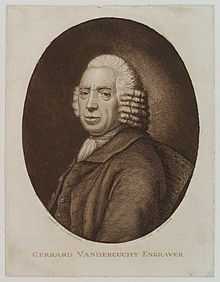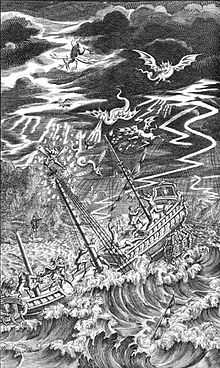Gerard Vandergucht


Gerard Vandergucht (or van der Gucht) (1696/7–18 March 1776) was an English engraver and art dealer.
Vandergucht, born in London, the elder son of the Flemish engraver Michael Vandergucht. He was taught engraving by his father, as was his younger brother Jan Vandergucht (or John) (c.1699-c.1730). Gerard was also taught drawing by Louis Chéron, and studied at Godfrey Kneller's Great Queen Street Academy.[1] He surpassed the restrained style of engraving favoured by his father, and became one of the leading engravers in London by adopting the French method of combining precise engraving with etched tones.[2]
In 1719, he was commissioned by James Thornhill to engrave four designs for the cupola of St Paul's Cathedral. He took over his father's house - the Golden Head in Queen Street, Bloomsbury - following his father's death in 1725. He married Mary Liney on 24 August, 1725. They had over 30 children, including the painter and picture dealer Benjamin Vandergucht.[2]
He became a leading publisher of engraved prints and book illustrations, and taught Robert White and Francis Patton.
In 1735, he took a leading role in the artists' demands for copyright protection which led to an extension of the provisions established by William Hogarth in the Engraving Copyright Act 1734. The 1734 act only protected original designs. Vandergucht and his supporters successfully lobbied to extend copyright protection to cover all prints.[3]
He concentrated on art dealing in the last 16 years of his life, selling prints, drawings, paintings and statues. He was a member of the Society for the Encouragement of Arts, Manufactures, and Commerce. He moved to Vandyke's Head, Great Brook Street, in 1758, where he died in 1776.
References
- ↑ National Portrait Gallery
- ↑ 2.0 2.1 Timothy Clayton, "Vandergucht, Gerard (1696/7–1776)", Oxford Dictionary of National Biography, Oxford University Press, 2004 [http://www.oxforddnb.com/view/article/28072, accessed 10 May 2011]
- ↑ Rose, Mark. Technology and Copyright in 1735: The Engraver's Act. The Information Society, Volume 21, Number 1, January–March 2005. pp. 63-66.